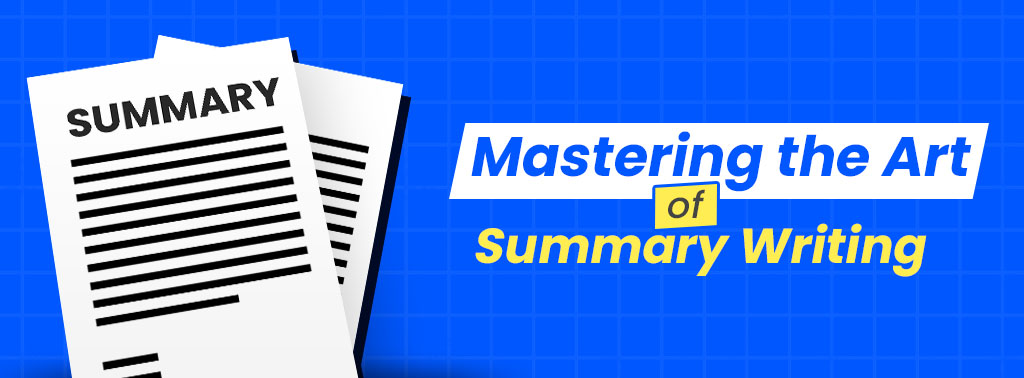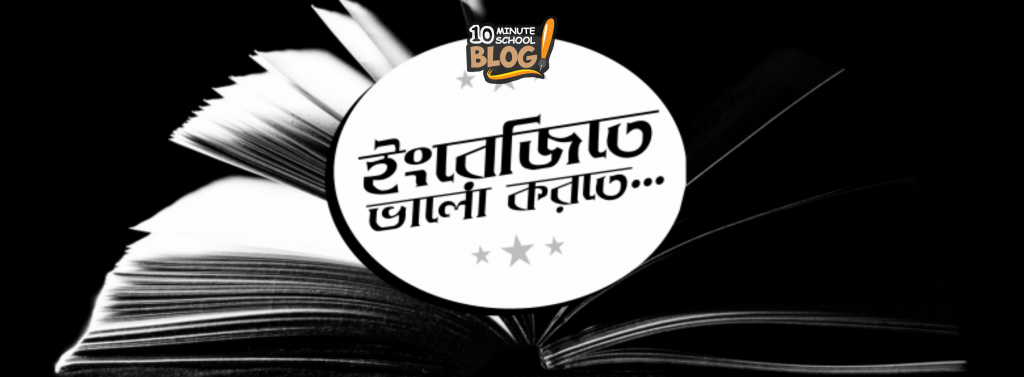It doesn’t matter which class you are in; if you are a student in the primary and high schools of Bangladesh, you will definitely have to write a summary in your English 1st paper exam. Despite our extensive experience in summary writing, many of us still struggle to receive a satisfactory score on this question. When it comes to the board exams, not achieving a competitive score in summary writing can have a significant negative impact on your total result. Failing to attain a high score in summary writing could potentially prevent you from securing an A+ in English 1st paper, which is already quite challenging to achieve in board examinations like SSC and HSC.
What is a Summary?
Now, what is a summary? So, according to the Cambridge Dictionary, a summary is a short, clear description that gives the main facts or ideas about something. A summary is a concise version of a longer text, speech, or document that captures the main ideas, key points, and essential information. The purpose of a summary is to provide readers or listeners with a brief and clear overview of the original content, allowing them to grasp the most important elements without having to go through the entire source material.
What is the purpose of summary writing?
Other than getting a good mark on summary writing, the purpose of a summary is to quickly give the reader or listener an idea of what this material is saying. A summary serves as a concise and focused overview of a longer text, speech, or document. It distills the key points and core message, aiding in retention, decision-making, and as a reference point.

When to Write a Summary
We have summary writing in our English first paper exams. Sometimes we have to write a summary of a familiar story or poem, while at other times it’s on a completely unknown topic. Regardless of the topic, if you know how to write a proper summary, you’ll definitely excel! Since summaries are commonly written in various contexts, here are some common situations and places where summaries are needed:
01. Academic Papers: Summaries can be found in academic articles, research papers, and theses, often as abstracts, to provide a concise overview of the study’s purpose, methodology, findings, and conclusions.
02. Academic Summarization Tests: In standardized tests such as the SAT, ACT, or IELTS, students are asked to provide summaries of reading passages to demonstrate their reading comprehension.
03. Project Proposals: Summaries are often required in project proposals, where the proposal’s main points and objectives are briefly outlined.
04. Academic Presentations: In academic presentations, speakers often include a summary slide or section at the beginning or end of their presentation to highlight key takeaways.
05. Education: Teachers may ask students to write summaries as assignments to assess their comprehension of lesson materials.
06. Scientific Abstracts: Scientific research papers include abstracts that provide a concise summary of the study’s goals, methods, results, and conclusions.
The list is not exhaustive, and there are many other purposes of summary writing out there!
English for Everyday
কোর্সটি করে যা শিখবেন:
Qualities of a Summary Writing
While writing a summary, there are a few qualities of a summary that you need to keep in mind:
01. Accuracy: Summaries must correctly reflect the main ideas without changing the meaning. So, read the text thoroughly and present the ideas correctly.
02. Conciseness: Keep it short and to the point. Capture the main ideas without adding extra details or repeating stuff.
03. Objectivity: Be neutral. Don’t put your personal opinions or interpretations into the summary.
04. Clarity: Make it easy to understand. Use simple and precise language to convey the main points clearly.
05. Comprehensiveness: Cover all the important parts of the original text without going into too much detail.
06. Structure: Organize your summary logically. It should flow smoothly, just like an organized closet.
07. No New Info: Don’t add new ideas or information that were not present in the original text.
08. Readability: Write in a way that grabs the reader’s attention and keeps them interested.
Now, let’s discuss one of the most crucial aspects of summary writing: its length. As a general guideline, a summary should typically be about one-fourth the length of the original work, which may range from 1 to 3 pages. Suppose the original text is a 20-line lesson about the history of Bangladesh. In that case, the summary should condense these 20 lines into about 5 lines, highlighting critical historical events, significant leaders, and their contributions to the struggle for independence. This concise version aids students in understanding the essential information from the text.
Things you should include in a Summary Writing
In a summary writing, you should include the following key elements:
Main Idea: Clearly convey the main idea or thesis of the original text. This is the central point that the author is trying to make.
Key Points: Summarize the most important points, arguments, or findings from the original text. These are the supporting details that help to explain and support the main idea.
Key Examples: If the original text includes illustrative examples, statistics, or anecdotes, include a few of the most relevant ones to support the key points.
Key Terms: Use terms or phrases from the original text if they are essential to understanding the topic. This ensures accuracy and clarity.
Context: Provide a brief context or background information if it’s necessary to understand the main idea and key points.
Tone: Consider the author’s tone (e.g., formal, informal, neutral) and try to reflect it appropriately in your summary.
Conciseness: Keep the summary concise, avoiding unnecessary details, examples, or repetition. The goal is to capture the essence of the text in a compact form.
Avoid Personal Opinions: A summary should be objective and not include your personal opinions or analysis of the text.
Citations: If required, include proper citations to credit the source, especially in academic or research summaries.
Structure: Organize the summary logically, typically in the same order as the original text, to make it clear and easy to follow.
Difference between a Summary and an Analysis
| Aspect | Summary | Analysis |
| Purpose | Gives a quick overview of the main points and key ideas in a shorter form | Dives deep into the source material to understand its meaning and importance |
| Content | Short and to the point, leaving out personal opinions | Goes into detail, often with personal views and interpretations |
| Length | Shorter, just highlighting the most crucial parts | Can be longer because it explores the source material in depth |
| Use of Quotes | Usually doesn’t include direct quotes from the source | Can include direct quotes to support arguments or explanations |
| Personal Input | Stays objective, doesn’t express personal thoughts | Encourages personal opinions and interpretations based on the source |
| Audience | For those who want a quick grasp of the main content | For readers who want to delve deeply into the source’s meaning and significance |
| Citation | Doesn’t require detailed citations since it’s a shorter version of the main content | Needs proper citations and references to give credit to the source material and support analysis |
Difference between Summarising and Paraphrasing
| Aspect | Summarising | Paraphrasing |
| Purpose | Condenses the main ideas, key details, and the central message of the source material | Rewrite the original text in your own words while maintaining the same meaning. |
| Content | Focuses on the essential elements, omitting less important details | Retains all the main points but presents them with different wording |
| Length | Typically shorter than the original text, capturing the core message concisely | Often of similar length to the original text but with different phrasing |
| Use of Quotes | Rarely includes direct quotations from the source material.\ | Do not use direct quotes, as the goal is to rephrase the content |
| Personal Input | Avoids personal opinions and interpretations, aiming for objectivity | Should not include personal opinions; it’s about rewording the original content |
| Audience | For readers who want a quick understanding of the main content in a more compact form | For those who want to avoid using the exact words of the source while conveying the same meaning |
| Citation | Doesn’t require direct citations if it’s a genuine summary | Should still include citations if you’re paraphrasing someone else’s work to give credit to the source |

Summary Writing Format
Here’s a clear and structured step-by-step format to help you master the art of writing a summary:
Step 1: Read the text carefully
While writing a summary in English, you should read the article more than once to make sure you’ve thoroughly understood it. First, scan the article quickly to get a sense of its topic and overall shape. Read the article carefully, highlighting important points and taking notes as you read. Skim the article again to confirm you’ve understood the key points, and reread any particularly important or difficult passage. For example, if you are reading a summary on Cox’s Bazar, first skim through the whole thing.
Step 2: Break the text down into sections
To make the text more manageable and understand its sub-points, break it down into smaller sections. For instance, you might explore topics like the location of Cox’s Bazar, its attractions, and the reasons for its fame.
Step 3: Identify the key points in each section and mark important lines
Now it’s time to go through each section and pick out its most important points. What does your reader need to know to understand the overall argument or conclusion of the article? Keep in mind that a summary does not involve paraphrasing every single paragraph of the article. Your goal is to extract the essential points, leaving out anything that can be considered background information or supplementary detail.
Step 4: Write the summary
Now that you know the key points that the article aims to communicate, you need to put them in your own words. It’s essential to properly paraphrase the author’s ideas. Do not copy and paste parts of the article, not even just a sentence or two. The best way to do this is to put the article aside and write out your own understanding of the author’s key points. A summary begins with an introductory sentence that states the text’s title, author, and the main point of the text as you see it. A summary is written in your own words.
Here are some key points to keep in mind for summary writing
- Introduction: Start with a brief introduction that includes the title of the original text, the author (if known), and a sentence summarizing the general topic or purpose of the text.
- Main Points: In the body of your summary, cover the main points or key ideas presented in the original text. Each main point should be presented in a separate paragraph.
- Conciseness: Be concise and avoid including unnecessary details or examples. Focus on the most critical information.
- Use of your own words: Paraphrase the information from the original text using your own words. Avoid direct quotations.
- Order: Maintain the order of the original text as much as possible to preserve the logical flow of ideas.
- Length: Ensure your summary writing is of an appropriate length, depending on the guidelines provided. For IELTS, aim for around 150 words.
- Cohesion: Use linking words and phrases (e.g., “Firstly,” “In addition,” “Moreover”) to create cohesion between your sentences and paragraphs.
- No Personal Opinions: A summary should be objective and not include your personal opinions or interpretations.
- Conclusion: End your summary with a concluding sentence that reiterates the main theme or message of the original text.
- Proofreading: After writing your summary, proofread it carefully to correct any grammatical or spelling errors.
Step 5: Check the summary against the article
After writing the summary, it’s essential to review it against the original article. Make sure your summary accurately reflects the main points and doesn’t misrepresent the information. This step helps ensure the integrity of your summary.
IELTS Course by Munzereen Shahid
কোর্সটি করে যা শিখবেন:
Examples of Summary Writing
To better grasp the art of writing summaries, here’s an example:
“In the article “Why Promoting a Reading Culture Could Promote Wellbeing,” Natalie Clarkson discusses how a workplace that encourages reading leads to greater satisfaction and higher productivity. Reading a book helps employees lower stress levels by allowing the reader to escape into imagination. The satisfaction that a reading culture offers also translates to less stress in the workplace, which maintains high levels of productivity. When employees are happier, they are more likely to stay with an organization and work more effectively as part of a team. All of these benefits make a workplace reading culture a positive influence on employee well-being
(Clarkson, Natalie. (2015) Why promoting a reading culture could promote well-being.)
Here:
- The opening line introduces the genre, title, author, and an overview of the article.
- The summary uses an objective tone without opinion.
- The author ends the summary with a closing line.
- The closing line restates the main points of the article, avoiding smaller details.
To understand the difference between a poorly written and a well-written summary, here’s a summary writing example to illustrate the distinction.
Passage:
The advent of digital technology has revolutionized the way we access and share information. With the proliferation of smartphones, tablets, and computers, people have unprecedented access to vast amounts of data at their fingertips. The internet serves as an inexhaustible source of knowledge and entertainment. Social media platforms have created new avenues for connecting people across the globe. However, this digital age also brings concerns about data privacy and security, as personal information is increasingly stored and shared online. Striking a balance between the convenience and risks of the digital world remains a critical challenge in the 21st century.
Poorly Written Summary
Digital technology has changed how we get and share information, and it’s easy with smartphones and computers. The internet has a lot of knowledge and fun. Social media lets us connect globally, but it’s not always safe.
Well Written Summary
The digital age, characterized by the widespread use of smartphones, tablets, and computers, has transformed information access and sharing. The internet provides an immense resource for knowledge and entertainment, while social media platforms facilitate global connections. However, the convenience of this digital world must be balanced with concerns about data privacy and security. Achieving this equilibrium stands as a significant challenge in the 21st century.
DOs & DON’Ts of Summary Writing
Here are some DOs & DON’Ts of summary writing:
DOs:
- Take note of the main theme.
- Pick out important supporting details.
- Write a chapter outline.
- Be objective.
- Brevity and clarity
Don’ts:
- Avoid details not included in the main text.
- Avoid first and second person point of view.
- Do not interject.
- Make it elaborate enough for a Summary Writing
These guidelines will help you create effective and well-crafted summaries.
Reporting Verbs in Summary Writing
Reporting verbs convey your stance toward the information source. Your stance can be ‘positive,’ ‘negative,’ or ‘neutral.’ If you disagree with the author, you’d use a negative reporting verb to express your disagreement. However, in Summary Writing, you do not provide your point of view.
| Reporting Verb | Usage |
| Say/Said | Report statements and opinions |
| State/Stated | Report facts and opinions |
| Argue/Argued | Report arguments or positions |
| Claim/Claimed | Report declarations and assertions |
| Highlight/Highlighted | Emphasize a key point |
| Emphasize/Emphasized | Stress a specific idea or aspect |
| Point out/Pointed out | Indicate a specific detail or fact |
| Note/Noted | Acknowledge or mention a particular aspect |
| Mention/Mentioned | Bring up something briefly without details |
| Conclude/Concluded | Summarize the author’s final thoughts |
Tools for Summary Writing
- Text Summarizer | Quillbot AI
- AI Summarizing Tool
- Free Text Summarizer
- Summary Writing App for Academic Writing
- AI Summarizing Tool | Grammarly
English Grammar Fundamentals
কোর্সটিতে যা যা পাচ্ছেন:
Summary Writing Checklist
Practice makes everything perfect, right? So, here are some ideas for practicing summary writing.
Firstly, Find an article in the newspaper, on the Internet, or in your book that is interesting to you and write a summary using the guidelines. Then, use the checklist below to edit your summary. If you marked no, then go back to your summary and fix it. Put a check in the Fixed box.
| Questions | Yes | No | Fixed |
| 1. Did you mention the author and the title of the article? | |||
| 2. Did you identify the main idea at the beginning of your summary? | |||
| 3. Did you include all the important points? | |||
| 4. Did you leave out the unnecessary details? | |||
| 5. Did you write the ideas in the order in which they appeared in the article? | |||
| 6. Did you keep the author’s meaning the same? | |||
| 7. Did you use your own words? | |||
| 8. Did you use citation expressions to refer to the author’s ideas? |
Frequently Asked Questions on Summary Writing
Here are some frequently asked questions (FAQs) on summary writing:
-
How can I make my summary more engaging?
Ans: To make your summary more engaging, consider incorporating compelling anecdotes or real-world examples, using descriptive language to vividly convey key points, and concluding with a thought-provoking statement or question that encourages further reflection.
-
What point of view should you use in summary Writing?
In summary writing, you should use the third-person point of view. Using the third person maintains an objective and formal tone and keeps the focus on the content being summarized rather than the summarizer’s perspective.
-
How do I avoid plagiarism in a summary?
To avoid plagiarism, rephrase the content in your own words rather than copying verbatim. Properly cite the source when necessary.
-
Can I include direct quotations in a summary?
It’s best to avoid direct quotations in a summary. Summarizing involves expressing ideas in your own words. However, if a direct quote is essential, use it sparingly and provide proper citation.
-
What tense should I use in summary writing?
Summaries are often written in the present tense to make them more immediate and engaging. However, consistency with the original text’s tense is also important.
-
How can I make my summary more concise?
To make a summary more concise, focus on the most important information, remove unnecessary details, and use clear and concise language.
-
Are there any common mistakes to avoid in summary writing?
Common mistakes include adding new information not present in the original text, expressing personal opinions, and failing to accurately represent the source’s main ideas.
At first, summary writing might seem challenging. However, the more you practice following our provided guidelines, the better you will become at mastering summary writing!
Explore our Free Courses:
- Study Abroad Complete Guideline
- English For Everyday
- Academic English Grammar
- English Grammar Fundamentals
- Pronunciation Mistakes
- Grammar Foundation Course
বছরজুড়ে অভিজ্ঞ টিচারদের সাথে ক্লাস 6-10 এর পড়াশোনা ও পরীক্ষার জন্য সেরা প্রস্তুতি নিতে আজই ভিজিট করো আমাদের অনলাইন ব্যাচ ২০২৫ -এ:
Check Out Our Skills Courses
- ঘরে বসে English Grammar
- Beginner’s English Bundle
- English Master Bundle
- ঘরে বসে Spoken English
- IELTS by Munzereen Shahid
Visit 10 Minute School’s website www.10minuteschool.com





আপনার কমেন্ট লিখুন